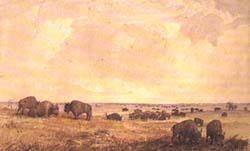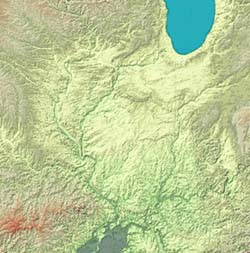
 |
| Herd of buffalo. (watercolor by Seth Eastman, 19th century) |
It should not be supposed that these lands . . . in the country of the Illinois are lands to which one has only to put the plow, for the greater part are drowned by ever so little rain. Others are too dry, and the best require considerable labor to clear off the aspens which cover them, as well as to drain the marshes which comprise wide areas. (René-Robert Cavalier, Sieur de La Salle, 1680)![]()
Illinois is a land of flat terrain and exceptionally rich soils. The land was leveled by a series of glaciers that covered much of the state during the last ice age (Pleistocene epoch: 10,000 to 1.5 million years ago). The glaciers pushed across Illinois like giant earthmovers, planing off hilltops and filling valleys with sand, gravel, and other sediment. When the glaciers melted away, they left behind a landscape that was often marshy but was very fertile and had tremendous agricultural potential. French fur traders predicted this potential in the late 1600s, but they also foresaw some of the difficulties farmers would face in preparing the land for agriculture. The wet, marshy ground in glaciated low spots required ditching and other forms of artificial drainage before fields could be plowed and crops planted.![]()
 |
| Shaded relief map of land in and near Illinois. |
|
|
Copyright © 2000 Illinois State Museum